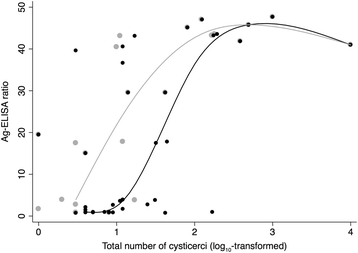Re-visiting the detection of porcine cysticercosis based on full carcass dissections of naturally Taenia solium infected pigs
- PMID: 29145875
- PMCID: PMC5693468
- DOI: 10.1186/s13071-017-2520-y
Re-visiting the detection of porcine cysticercosis based on full carcass dissections of naturally Taenia solium infected pigs
Abstract
Background: Taenia solium is a neglected zoonotic parasite. The performances of existing tools for the diagnosis of porcine cysticercosis need further assessment, and their shortcomings call for alternatives. The objective of this study was to evaluate the performance of tongue palpation and circulating antigen detection for the detection of porcine cysticercosis in naturally infected pigs of slaughter age compared to full carcass dissections (considered the gold standard). Additionally, alternative postmortem dissection procedures were investigated. A total of 68 rural pigs of slaughter age randomly selected in the Eastern Province of Zambia were dissected. Dissections were conducted on full carcasses (or half carcass in case cysticerci were already detected in the first half), including all the organs. Total cysticercus counts, location and stages were recorded and collected cysticerci were identified morphologically and molecularly. All sera were analysed with the B158/B60 antigen detecting ELISA (Ag-ELISA).
Results: Key findings were the high occurrence of T. solium infected pigs (56%) and the presence of T. solium cysticerci in the livers of 26% of infected animals. More than half of the infected carcasses contained viable cysticerci. Seven carcasses had T. hydatigena cysticerci (10%), out of which five carcasses were co-infected with T. hydatigena and T. solium; two carcasses (3%) had only T. hydatigena cysticerci. Compared to full carcass dissection, the specificity of the Ag-ELISA to detect infected carcasses was estimated at 67%, the sensitivity at 68%, increasing to 90% and 100% for the detection of carcasses with one or more viable cysticerci, and more than 10 viable cysts, respectively. Tongue palpation only detected 10% of the cases, half carcass dissection 84%. Selective dissection of the diaphragm, tongue and heart or masseters can be considered, with an estimated sensitivity of 71%, increasing to 86% in carcasses with more than 10 cysticerci.
Conclusions: Depending on the aim of the diagnosis, a combination of Ag-ELISA and selective dissection, including investigating the presence of T. hydatigena, can be considered. Full carcass dissection should include the dissection of the liver, kidneys, spleen and lungs, and results should be interpreted carefully, as small cysticerci can easily be overlooked.
Keywords: Antigen ELISA; Cysticercosis; Dissection; Liver; Pig carcass; Taenia solium; Tongue palpation.
Conflict of interest statement
Ethics approval and consent to participate
All procedures employed in this study were approved by the University of Zambia Biomedical Research Ethics Committee (004–09-15) and the Ministry of Agriculture and Livestock, Lusaka- Zambia.
Consent for publication
Not applicable.
Competing interests
The authors declare that they have no competing interests.
Publisher’s Note
Springer Nature remains neutral with regard to jurisdictional claims in published maps and institutional affiliations.
Figures


Similar articles
-
Performance of Ag-ELISA in the diagnosis of Taenia solium cysticercosis in naturally infected pigs in Tanzania.Parasit Vectors. 2020 Oct 27;13(1):534. doi: 10.1186/s13071-020-04416-4. Parasit Vectors. 2020. PMID: 33109255 Free PMC article.
-
Ineffectiveness of meat inspection in the detection of Taenia solium cysticerci in pigs slaughtered at two abattoirs in the Eastern Cape Province of South Africa.Vet Parasitol Reg Stud Reports. 2019 Aug;17:100299. doi: 10.1016/j.vprsr.2019.100299. Epub 2019 Apr 24. Vet Parasitol Reg Stud Reports. 2019. PMID: 31303223
-
Taenia hydatigena in pigs in Burkina Faso: A cross-sectional abattoir study.Vet Parasitol. 2016 Oct 30;230:9-13. doi: 10.1016/j.vetpar.2016.10.022. Epub 2016 Oct 24. Vet Parasitol. 2016. PMID: 27884445 Free PMC article.
-
The emergence of Taenia solium cysticercosis in Eastern and Southern Africa as a serious agricultural problem and public health risk.Acta Trop. 2003 Jun;87(1):13-23. doi: 10.1016/s0001-706x(03)00051-2. Acta Trop. 2003. PMID: 12781374 Review.
-
Mapping occurrence of Taenia solium taeniosis/cysticercosis and areas at risk of porcine cysticercosis in Central America and the Caribbean basin.Parasit Vectors. 2017 Sep 18;10(1):424. doi: 10.1186/s13071-017-2362-7. Parasit Vectors. 2017. PMID: 28923090 Free PMC article. Review.
Cited by
-
Effects of 'The Vicious Worm' educational software on Taenia solium knowledge among key pork supply chain workers in Zambia.PLoS Negl Trop Dis. 2020 Oct 19;14(10):e0008790. doi: 10.1371/journal.pntd.0008790. eCollection 2020 Oct. PLoS Negl Trop Dis. 2020. PMID: 33075045 Free PMC article.
-
Performance of a Sandwich Antigen-Detection ELISA for the Diagnosis of Porcine Taenia solium Cysticercosis.Am J Trop Med Hyg. 2019 Mar;100(3):604-608. doi: 10.4269/ajtmh.18-0697. Am J Trop Med Hyg. 2019. PMID: 30652670 Free PMC article.
-
Implementation of a practical and effective pilot intervention against transmission of Taenia solium by pigs in the Banke district of Nepal.PLoS Negl Trop Dis. 2019 Feb 25;13(2):e0006838. doi: 10.1371/journal.pntd.0006838. eCollection 2019 Feb. PLoS Negl Trop Dis. 2019. PMID: 30802248 Free PMC article.
-
Confirmation by necropsy of a high prevalence of porcine cysticercosis in a rural district of Madagascar.Parasitology. 2023 Aug;150(9):852-857. doi: 10.1017/S0031182023000653. Epub 2023 Jul 7. Parasitology. 2023. PMID: 37496390 Free PMC article.
-
Immunodiagnostic usefulness of monoclonal antibodies specific to conformational epitopes of Taenia solium oncosphere protein TSOL18.J Immunol Methods. 2021 Oct;497:113121. doi: 10.1016/j.jim.2021.113121. Epub 2021 Aug 2. J Immunol Methods. 2021. PMID: 34352238 Free PMC article.
References
-
- Murrell KD. In: WHO/OIE/FAO guidelines for the surveillance, prevention and control of Taeniosis/Cysticercosis. Murrell KD, editor. Paris, France: World Health Organization for Animal Health (OIE); 2005. pp. 57–71.
-
- World Health Organization. Estimates of the global burden of foodborne diseases (FERG), 2015. Geneva: World Health Organization; 2015.
MeSH terms
Substances
Grants and funding
LinkOut - more resources
Full Text Sources
Other Literature Sources
Miscellaneous

